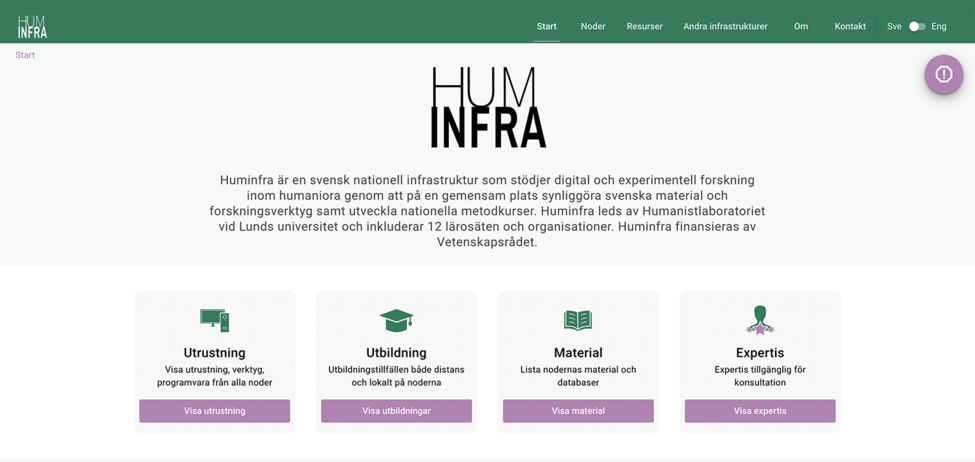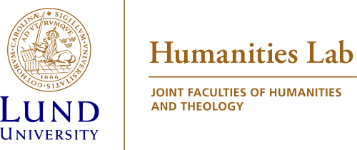New web platform enables easier access to research methods in digital and experimental Humanities

The research infrastructure Huminfra, led by Lund University Humanities Lab and financed by the Swedish Research Council, is now taking physical form through the web-based information platform huminfra.se. The web platform compiles and links to existing digital/e-scientific data sets, tools, expertise and educational opportunities spread across Sweden – resources that the individual researcher previously had to spend a lot of time identifying and learning to use.
- It can be challenging for many researchers to find the equipment, the right materials or educational opportunities related to new research methods. Huminfra will make it easier for them to conduct the research they want with the methods they want to use – regardless of where in Sweden they live, says Marianne Gullberg, Professor of Psycholinguistics at Lund University and Director of Huminfra and Lund University Humanities Lab.
Research in the Humanities is multi-facetted and researchers use several different approaches, methods and techniques. It includes everything from the use of eye-tracking to understand school children’s reading development, to AI-based image analysis to study rock carvings, laser scanning and computer animation of archaeological finds, tests of ChatGPT, and studies of medieval maps combined with register data of population statistics. These new approaches require new methods and expertise.
Huminfra – a consortium of 12 universities and organisations
Huminfra is a consortium consisting of 12 Swedish universities and organisations, or nodes, as they are called within the infrastructure. The beta version of huminfra.se, which has been available online since mid-January, initially contains resources from Lund and Umeå universities. During the spring, the resources of the remaining nodes will be added, and the web platform is expected to be fully operational by the summer of 2023. Meanwhile, other ongoing work within the infrastructure include developing new national method courses as well as preparing and applying for Swedish membership in the European Research Infrastructure Consortium, The Digital Research Infrastructure for the Arts and Humanities (DARIAH-EU).
- Huminfra provides Swedish Humanities with a competitive edge and new opportunities for impact by giving researchers in Sweden easier access to both Swedish and international tools and resources. In addition, it gives international researchers new avenues to find unique Swedish materials and resources – such as data on languages spoken in Sweden, and Swedish cultural heritage data, says Marianne Gullberg.
Facts
Huminfra is a Swedish national infrastructure supporting digital and experimental research in the Humanities by providing users with a single entry point for finding existing Swedish materials and research tools, as well as developing national method courses. Huminfra is a consortium consisting of 12 universities and organisations, coordinated by Lund University Humanities Lab.
The 12 Huminfra Consortium nodes are:
1. Lund University, Humanities Lab
2. Humlab, Umeå University
3. Digital Humanities, Linnaeus University
4. Gothenburg Research Infrastructure in the Humanities, University of Gothenburg
5. Språkbanken Text, University of Gothenburg
6. Språkbanken Tal, KTH/the Royal Institute of Technology
7. Digital Human Science, Stockholm University
8. KBLab, National Library of Sweden
9. The Swedish National Archives
10. Centre for Digital Humanities, Uppsala University
11. Swedish School of Library and Information Science, University of Borås
12. Digital Laboratory Centre, Halmstad University
A beta version of the web-based information platform is available on: www.huminfra.se
Huminfra is also found on Linkedin, Twitter and Instagram as @huminfra_sweden
More information
Marianne Gullberg, Professor of Psycholinguistics at Lund University and Director of Huminfra Lund University Humanities Lab
Tel. +46 (0)46 2220389
Email: marianne.gullbergling.luse
Anna Blåder, Communications officer for Huminfra at Lund University Humanities Lab
Tel. +46 (0)46 2223091
Email: anna.bladerhumlab.luse
